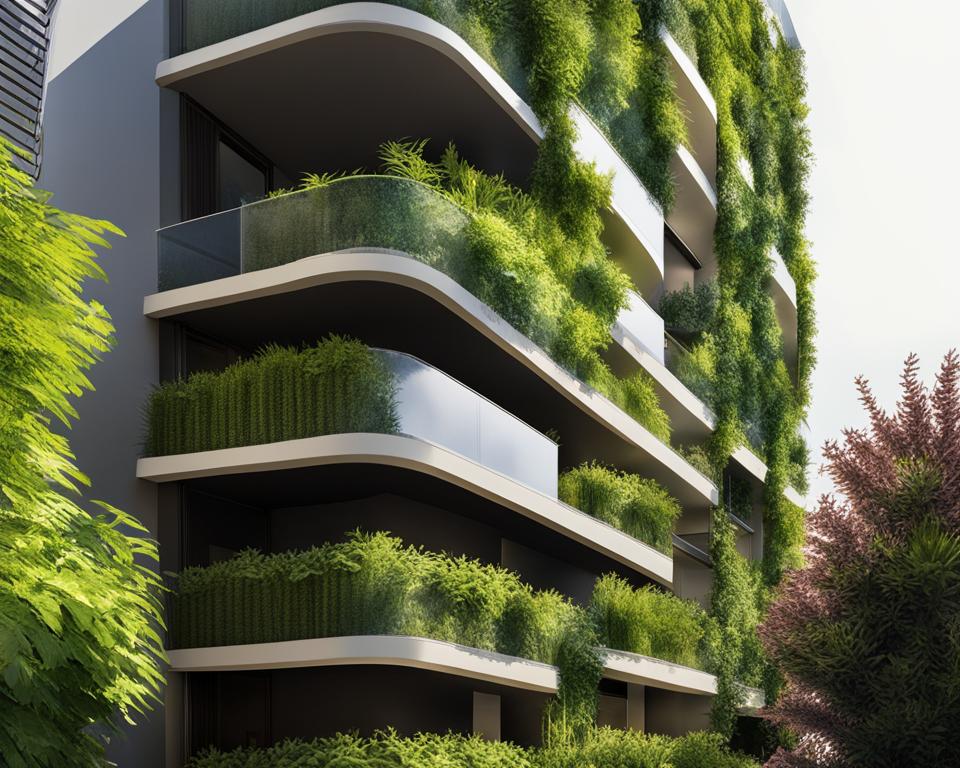For gardening enthusiasts with limited space, a vertical gardening tower for small spaces offers a practical and efficient solution. With a rising interest in space-efficient gardening, urban dwellers can enjoy the benefits of a lush garden while maximizing their available area. Thanks to their versatile and compact designs, these towers make it easy to grow plants and vegetables without sacrificing valuable space. In this article, we will guide you through the benefits of a small space garden tower and share valuable tips to help you grow your dream garden vertically.
Key Takeaways
- A space-efficient vertical gardening tower helps maximize the area in small gardens, balconies, and patios.
- Vertical gardening towers are aesthetically appealing and can enhance the beauty of your urban living space.
- Grow your own vegetables, fruits, and herbs in a small space garden tower for easy access to fresh produce.
- Choose the right size, design, and material for your vertical gardening tower to meet your unique gardening needs.
- Proper sunlight and shade management, plant selection, and installation are crucial for a successful vertical garden.
- Ensure proper maintenance and care of your compact vertical gardening tower, including watering, nutrient management, and pest control strategies.
Introduction to Vertical Gardening Towers
For gardening enthusiasts dealing with space constraints, the concept of a compact vertical gardening tower can be a game-changer. These innovative structures offer a practical and aesthetically pleasing solution to those looking to cultivate plants in small gardens or urban spaces. In this section, we will briefly introduce what vertical gardening towers are, the key design principles, and why they hold immense potential for making the most of limited space while growing plants that thrive.
At its core, a vertical garden tower for small gardens is a sustainable, space-efficient, and modern approach to gardening. Traditional gardens often require large swathes of horizontal space, which might not always be an option for those in urban dwellings. Vertical gardening towers, on the other hand, enable the growth of plants in an upward direction, with multiple tiers or compartments stacked vertically. This allows users to grow a variety of plants – from ornamentals to herbs and even fruits – within a compact structure, making the most of the vertical space available.
“Vertical gardening towers are an excellent solution to the challenges posed by gardening in small spaces, enabling the cultivation of a variety of plants in a visually striking, resource-efficient manner.”
There are various designs and materials available for vertical gardening towers, but the essential design principles remain consistent across the board. A well-designed tower will usually include:
- Sturdy, durable framework and support structure to sustain the weight of the plants, soil, and water
- Well-ventilated compartments, ensuring adequate air circulation and sunlight exposure for optimal plant growth
- An efficient watering or irrigation system, allowing for easy watering by conserving both water and time
As you venture into the world of vertical gardening, you’ll come to appreciate the immediate benefits these structures offer. They make gardening more accessible, enjoyable, and visually appealing in small spaces, lending a touch of natural beauty and serenity to even the tightest nooks and crannies. And, with their effective use of limited space, vertical gardening towers are set to revolutionize the way we approach urban gardening.
In the sections that follow, we will delve deeper into the benefits, designs, and tips for effectively using vertical garden towers for small gardens – ensuring you can nurture a thriving, vibrant garden in your small space.
The Benefits of a Vertical Garden Tower for Urban Spaces
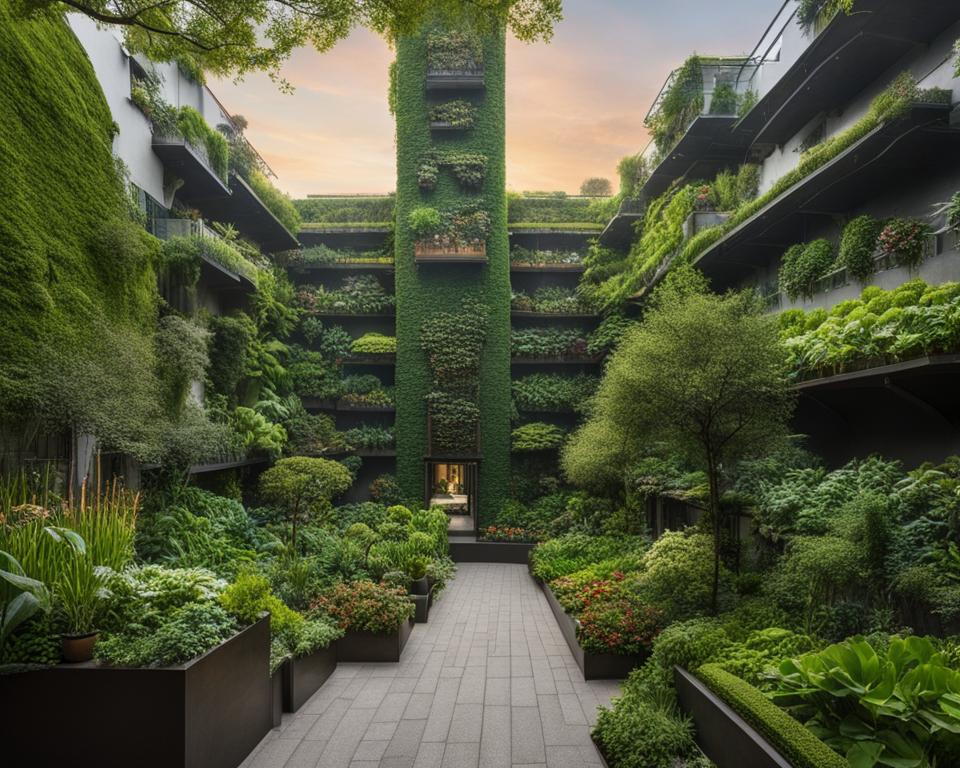
As urban dwellers continue to face the challenge of limited space, vertical garden towers emerge as an innovative and practical solution for maximizing small balconies, patios, or backyards. A space-saving vertical gardening tower can transform the way you garden, offering a range of benefits that address common urban gardening concerns. In this section, we’ll explore the advantages of using a vertical garden tower for urban spaces, including how it maximizes limited space, enhances aesthetic appeal, and increases accessibility to fresh produce.
Maximizing Limited Space
One of the main advantages of a vertical garden tower is its ability to optimize limited space while still providing ample room to grow your favorite plants. Vertical gardening towers can accommodate a wide variety of plants, offering impressive flexibility to grow vegetables, herbs, and even some fruits depending on your preferences and space constraints.
An effective vertical garden tower can offer up to 4x the growing space of a traditional, horizontal garden bed in the same area, making it an ideal choice for those who are tight on space but still want to maintain a lush and thriving garden.
Furthermore, vertical garden towers are specially designed to retain water and nutrients more effectively than their horizontal counterparts, which ensures that your plants stay healthy and nurtures their growth effectively within a limited space.
Enhancing Aesthetic Appeal
Another benefit of a vertical garden tower is its ability to enhance the aesthetic appeal of your urban living space. A well-designed vertical gardening tower can become a focal point of your balcony or patio, adding visual interest and beauty to your outdoor areas.
Vertical garden towers are available in various designs, materials, and styles, so you can easily find one that complements your home’s existing decor. Combining functionality with visual appeal, vertical gardening towers make it possible for city dwellers to enjoy a beautiful and organized garden in the most confined of spaces.
Increasing Accessibility to Fresh Produce
Vertical garden towers allow urban dwellers to grow their own supply of fresh vegetables, herbs, and fruits, fostering a farm-to-table lifestyle regardless of their living situation. By cultivating a vertical garden tower, you can enjoy the benefits of freshly harvested produce all year round. Moreover, growing your own food is not only an eco-friendly alternative to purchasing store-bought produce but also a cost-effective way to maintain a healthy and sustainable lifestyle.
- Grows a wide variety of vegetables, such as lettuce, spinach, kale, and tomatoes
- Provides the opportunity to cultivate various types of herbs, including basil, mint, and parsley
- Supports small fruit plants, like strawberries and blueberries, dependent on the specific vertical garden tower setup
Vertical garden towers, by enabling urban dwellers to make the most of their limited spaces, can play a pivotal role in enhancing city living experiences. Not only do these towers make gardening a feasible hobby or passion for people with restricted outdoor areas, but they also contribute to the overall aesthetics and sustainability of urban environments.
Choosing the Right Vertical Gardening Tower for Your Small Space
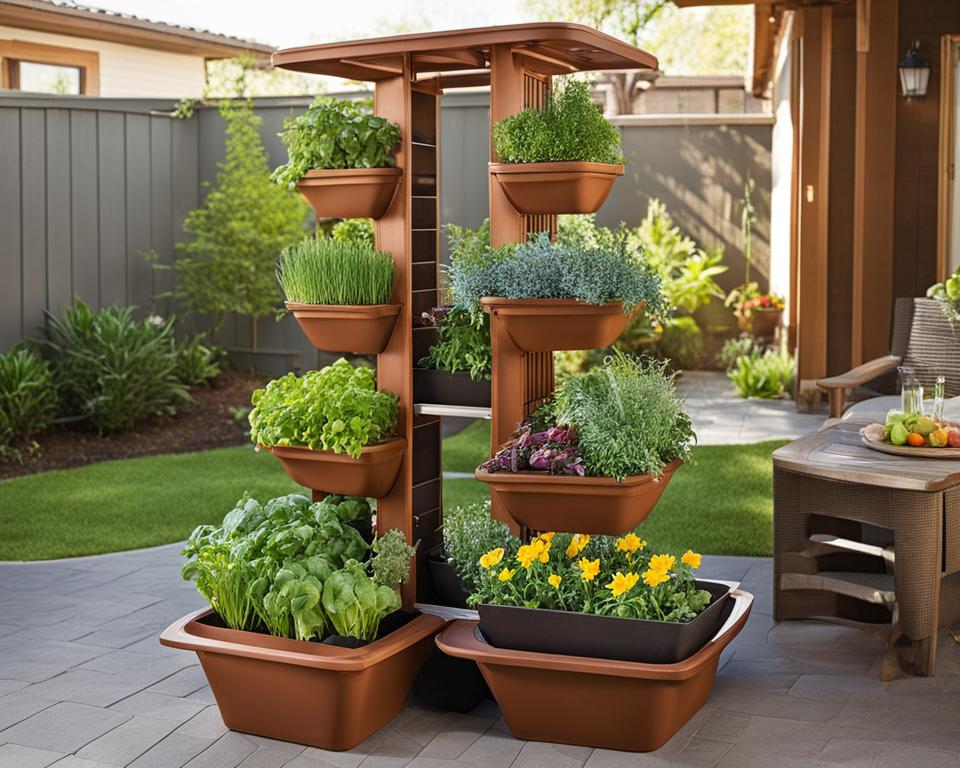
When it comes to selecting the ideal vertical garden tower for small areas, it’s crucial to consider various factors such as design, materials, and size. This section will guide you through these essential aspects to ensure you find the perfect fit for your unique space and gardening needs.
Design
Choosing the right design for your vertical gardening tower involves finding a structure that not only meets the needs of your plants but also visually complements your space. The following table presents three popular vertical garden tower designs, each with its advantages:
| Design | Description | Advantages |
|---|---|---|
| Stacked Planters | Multiple individual planters stacked on top of each other, forming a tower | Easy to assemble, customizable with different planter sizes, and simple to re-arrange if needed |
| Vertical Pocket Gardens | A fabric or plastic wall-mounted structure with pockets or compartments for holding plants | Lightweight, space-saving, and affordable option for growing a variety of plant species |
| Vertical Ladder Planter | A ladder-like structure with horizontal shelves or platforms for planters | Offers an organized display, flexibility in plant arrangement, and easy access for gardening activities |
Materials
Materials used to construct vertical gardening towers range from wood and metal to plastic and fabric. When choosing your preferred material, consider factors such as durability, maintenance, and cost:
- Wooden: Although aesthetically pleasing and eco-friendly, wooden towers might require more maintenance due to susceptibility to rot and insects.
- Metal: Metal towers, like those made of stainless steel or aluminum, offer durability and strength but may cost more compared to other materials.
- Plastic: Plastic towers are typically lightweight, affordable, and low-maintenance, but might not provide the same sturdiness as wooden or metal towers.
- Fabric: Fabric towers, as seen in vertical pocket gardens, are lightweight and easy to install but may require extra care to prevent water damage and mold growth.
Size
Before purchasing a vertical garden tower, measure your available space, and consider the size of the tower that would work best for your needs. Keep in mind the mature size and growth requirements of the plants you plan to grow, as well.
To find the right fit, take into account your available space, number of plants, and the size of the pots or pockets required to accommodate your chosen plant species.
By carefully considering these factors, you can confidently choose the perfect vertical garden tower for your small space, creating a thriving and visually appealing garden that maximizes every inch of your limited area.
Design Elements for Your Small Space Vertical Garden Tower
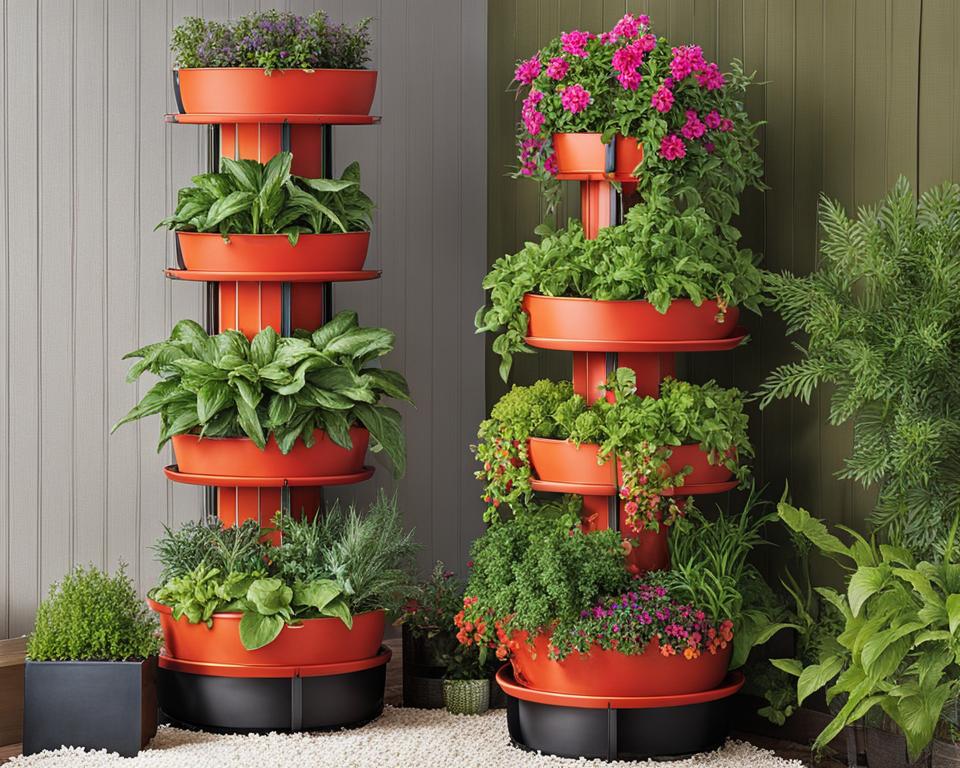
Creating a beautiful and productive vertical garden in limited space involves careful planning and consideration for various design elements. In this section, we’ll discuss two crucial factors for designing your vertical gardening tower for small spaces: sunlight requirements and selecting suitable plants.
Considering Sunlight and Shade
When designing your vertical garden tower, it’s essential to analyze the sun exposure and shading requirements of the plants you intend to grow. Matching plants’ sunlight preferences with appropriate placement within the tower can greatly impact growth and productivity. To help you make informed choices, consider the following strategies:
- Observe your space: Examine the area where you plan to place your vertical gardening tower throughout the day. Determine which parts get direct sunlight, and how long the sunlight lasts.
- Arrange plants according to their preferences: Place sun-loving plants, such as tomatoes, peppers, and kale, near the top of the tower to receive optimal sun exposure. Shade-tolerant plants, including lettuce and spinach, should be positioned lower on the tower to thrive in less direct sunlight.
- Rotate your tower: Adjust the position of your vertical garden to ensure all plants receive adequate sunlight. Rotating your tower periodically can help distribute sunlight evenly, promoting balanced growth.
Selecting Suitable Plants for Your Vertical Garden
Choosing the right plants is crucial to the success of any garden, especially when working with limited space. Consider the following factors when selecting plants well-suited for your vertical gardening tower:
- Compactness: Opt for plants with limited root growth and compact forms, such as strawberries, dwarf tomatoes, and small succulents, to make the most of your limited space.
- Compatibility: Ensure the plants you select have similar sunlight, temperature, and watering requirements for easier maintenance.
- Functionality: Decide whether you want your vertical garden tower to focus on edible plants, aesthetically pleasing foliage, or a combination of both. This will inform your plant selection process.
Here are some recommendations for plants suitable for different vertical garden environments:
| Edible Plants | Ornamental Plants | Plants for Indoor Vertical Gardens |
|---|---|---|
| Lettuce | Fern | Spider Plant |
| Dwarf Tomato | Hosta | Pothos |
| Peppers | Heuchera | ZZ Plant |
Designing a successful vertical garden tower for small spaces requires careful attention to sunlight and plant requirements. With thoughtful consideration and planning, you can create a flourishing vertical garden that maximizes your limited space and brings beauty and freshness to your urban environment.
Installation Tips for a Space-Saving Vertical Gardening Tower
Setting up a vertical gardening tower can be simple and straightforward, enabling you to transform your limited space into a productive garden. In this section, we will discuss some essential tips and considerations for the installation process, ensuring a seamless experience as you incorporate a vertical gardening system into your small area.
One of the initial steps in installation is finding the ideal spot for your vertical gardening tower. It should be in an area with sufficient sunlight, good drainage, and enough space for tower expansion if necessary. Additionally, ensure that it’s easily accessible for watering, pruning, and harvesting.
Select a Sturdy Base
Since vertical gardening towers can be top-heavy when fully loaded with plants and soil, a stable and level base is essential to prevent tipping. You may need to place your tower on a solid surface, like a concrete pad, or secure it with stakes or weights to maintain stability.
“Investing time in the prep work before installing your vertical gardening tower will lead to a more successful and satisfying gardening experience.”
Create a Convenient Watering System
Irrigation is pivotal for a thriving vertical garden, so plan your watering system during the installation process. A drip irrigation system is a popular choice, as it delivers a steady supply of water to multiple points with less water waste. However, hand watering can also be effective if you’re diligent about keeping up with your plants’ needs.
Install the Tower Modules
- Assemble the base of your tower according to the manufacturer’s instructions, ensuring it is secured and level.
- Place the planting modules on top of the base, stacking them to create the desired height. Make sure they fit securely together and do not pose a tipping hazard.
- Once your tower is assembled, fill the planting modules with a high-quality potting mix, leaving room for your plants’ roots to grow.
- Transplant your selected plants into the planting pockets, being careful not to overcrowd them. A general rule is to space plants according to their mature size, allowing for optimal airflow and growth.
- Connect your watering system, if applicable, and make any final adjustments to ensure your tower stays protected and stable in its location.
By following these installation tips for your vertical gardening tower, you will be well on your way to enjoying a bountiful harvest in your small space. Remember, investing time in the prep work before installing will lead to a more successful and satisfying gardening experience.
Maintenance and Care for Your Compact Vertical Gardening Tower
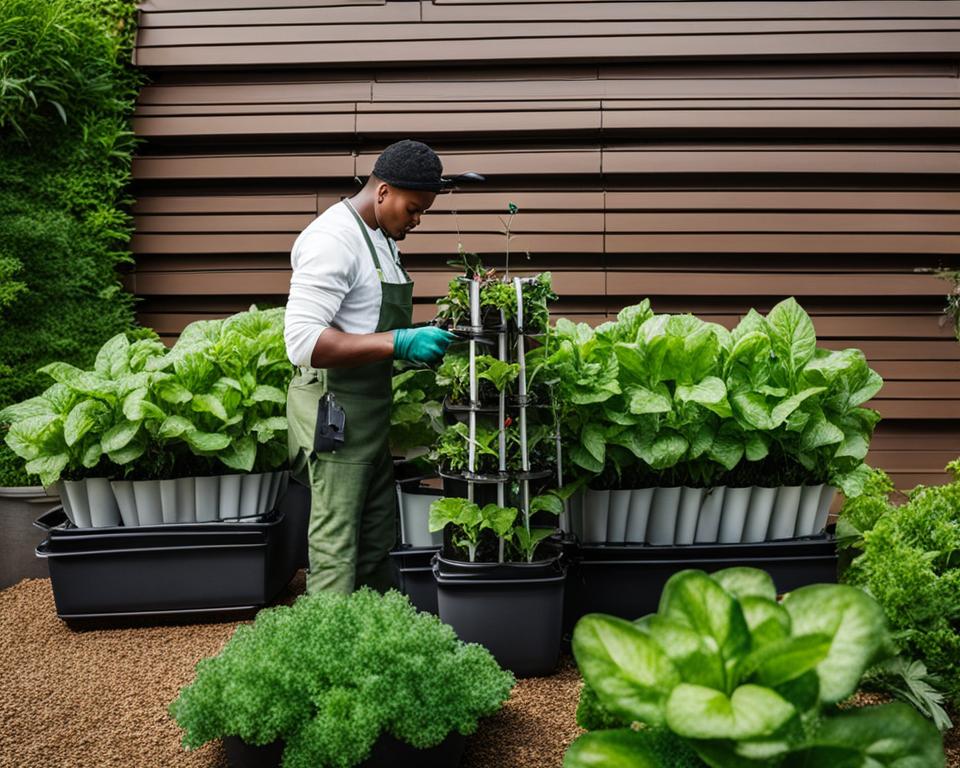
A vital aspect of owning a compact vertical tower garden is ensuring proper maintenance and care for the plants. In this section, we will guide you through watering solutions for vertical gardens, managing nutrients and soil health, and effective pest and disease control methods.
Watering Solutions for Vertical Gardens
Vertical garden tower care starts with a reliable watering system. As plants in a vertical garden may have different watering needs, a drip irrigation system is an excellent space-efficient solution. Drip irrigation provides a slow, steady, and consistent water supply to each plant, reducing water waste and ensuring that your plants receive adequate hydration.
- Drip Irrigation: A system that provides water directly to the roots of the plants, with customizable soaker hoses or emitters. This easy-to-install solution saves water and minimizes maintenance.
- Self-watering Containers: Vertical gardening containers with built-in reservoirs that store water, providing a constant supply to plants in need.
Managing Nutrients and Soil Health
Equally important for vertical garden tower care is maintaining a nutrient-rich environment for plants. Proper soil management encompasses different practices like:
- Using high-quality, organic potting mix that provides essential nutrients and allows for proper drainage.
- Regularly feeding your plants with a balanced fertilizer to supply them with the nutrients they need to grow.
- Rotating plant locations within the tower to prevent soil depletion and allow for a balanced dispersion of nutrients.
“Healthy soil is the foundation for strong, robust plants. Give your vertical tower garden the nourishment it needs by maintaining nutrient-rich soil.”
Pest and Disease Control in Vertical Towers
Inevitably, as with any garden, a vertical garden may face challenges from pests and diseases. To protect your compact vertical tower garden, try these strategies:
| Pest Control Strategies | Disease Control Strategies |
|---|---|
| Introduce natural predators (e.g., ladybugs and lacewings) | Practice proper sanitation, removing dead plant material |
| Use organic pest control solutions (e.g., neem oil and diatomaceous earth) | Choose disease-resistant plant varieties |
| Regularly inspect and monitor your garden for early signs of infestations | Maintain proper airflow by spacing plants appropriately |
Implementing preventive measures and taking prompt action against pest and disease outbreaks will go a long way in maintaining the health and vitality of your compact vertical tower garden.
Embrace the Advantages of Vertical Gardening Towers for Urban Living
In summary, vertical gardening towers present an excellent solution for urban dwellers looking to maximize their limited spaces and enjoy the numerous benefits of growing their plants, despite the constraints of city living. Embracing a vertical gardening tower not only helps make the most out of your small area, but it also provides an opportunity to enhance aesthetic appeal while increasing accessibility to fresh, home-grown produce. Through this innovative approach, anyone can experience the wonder and satisfaction of urban gardening no matter how limited their space is.
Selecting the right vertical gardening tower and carefully considering the design elements and plant choices will ensure that your urban garden thrives. Proper installation and maintenance, such as adopting appropriate watering solutions and nutrient management strategies, are also crucial for the success of your vertical garden. When faced with potential challenges like pests and diseases, staying informed on the best practices for prevention and control will help you maintain a healthy and bountiful garden.
In a world where space is often scarce, especially in urban environments, vertical gardening towers offer the perfect solution to the constraints of small spaces. With their numerous benefits, efficiency, and sheer beauty, these structures have the potential to revolutionize urban gardening and enable city dwellers to experience the joy of cultivating their plants, reaping the rewards of their effort, and improving their overall quality of life. So, explore the possibilities of a vertical gardening tower and indulge in the joy of growing your beautiful urban garden.
FAQ
What is a vertical gardening tower?
A vertical gardening tower is a space-saving gardening solution designed to grow plants vertically instead of spreading out horizontally. It’s an excellent option for small spaces, urban settings, balconies, or patios, allowing garden enthusiasts to grow more plants in limited areas.
What are the benefits of using a vertical gardening tower for small spaces?
Vertical gardening towers offer numerous benefits, including maximizing limited space, enhancing aesthetic appeal, improving accessibility to fresh produce, reducing the need for weeding, and making it easier to manage pests and diseases. These towers are especially useful in urban spaces where horizontal area for gardening is limited or non-existent.
How do I choose the right vertical gardening tower for my small space?
When selecting a vertical gardening tower, consider factors like the tower’s design, materials, size, and compatibility with your chosen plants. It’s important to find a tower that complements your space’s aesthetics while also meeting your gardening needs and making the most of the available area.
What design elements should I keep in mind for my small space vertical garden tower?
To optimize the success of your vertical garden, consider your space’s sunlight and shade levels, the types of plants that will thrive in a vertical environment, and the placement and layout of your vertical gardening tower. Additionally, plan for proper irrigation, good air circulation, and an accessible maintenance routine to ensure your plants remain healthy and thriving.
What plants are suitable for a small space vertical garden tower?
Many plants are well-suited for vertical gardens, including ornamental flowers, herbs, vegetables, and even some fruits. When selecting plants, opt for those that have shallow root systems, are naturally vining or trailing, and do not require extensive horizontal space to grow. Examples include lettuce, strawberries, nasturtiums, and various herbs.
What are some tips for installing a space-saving vertical gardening tower?
Some installation tips for a vertical gardening tower include ensuring that your chosen location receives adequate sunlight, assessing the weight requirements and structural support of the tower, installing a sturdy and effective watering system, and including plants in your design to make the tower visually appealing and functional.
How do I care for and maintain my compact vertical gardening tower?
Maintenance and care for a compact vertical gardening tower involve proper watering practices, managing plant nutrients and soil health, and utilizing effective pest and disease control measures. Utilize a consistent and efficient irrigation system to meet unique vertical garden water requirements, maintain nutrient-rich soil, and monitor for pests and diseases to keep your vertical garden flourishing.

